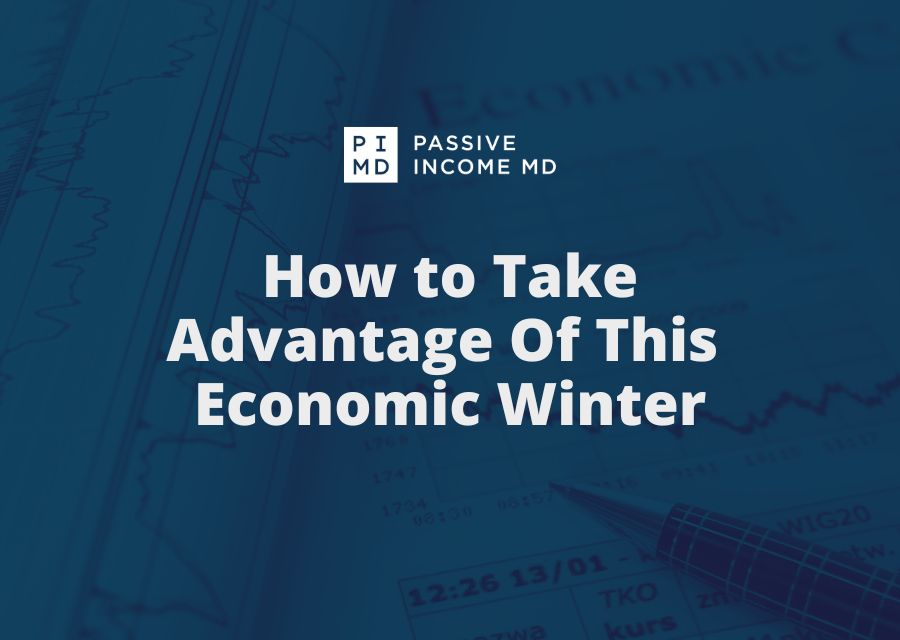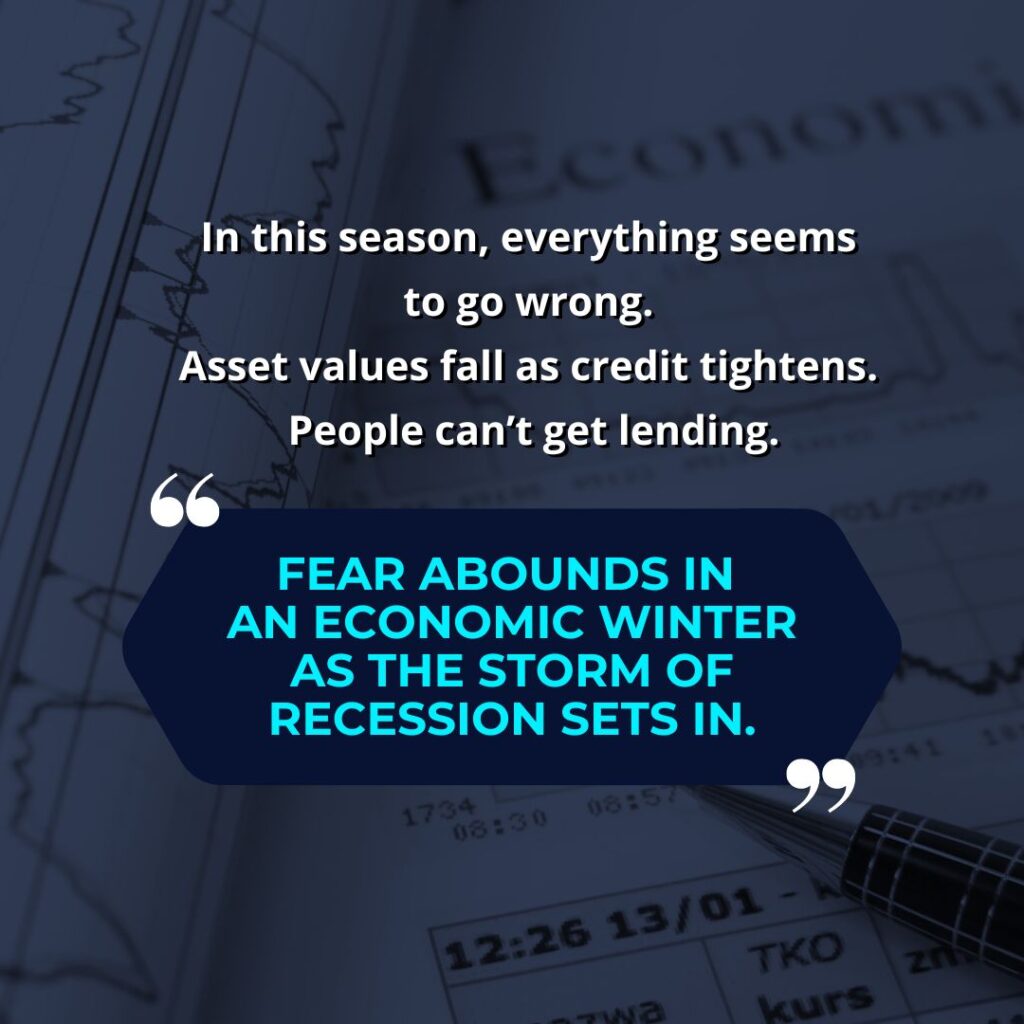
How to Take Advantage of This Economic Winter
This post may contain links from our sponsors. We provide you with accurate, reliable information. Learn more about how we make money and select our advertising partners.
Life is about patterns and cycles. Like the seasons, things repeat over time.
Many of you know that, just like the weather, there are four economic seasons. But unlike the weather, economic seasons can last months or even years.
For those readers unfamiliar with the concept, it may not surprise you to discover that an “economic winter” is a state of recession or being on the precipice of one. And if you’ve been alive long enough, you’ve seen your fair share of economic downturns. When they occur, it can feel like everything is coming down on us.
But if you look at history, zoom out, and take the macro view, you can see that a new cycle of growth is inevitably on the horizon. And while in the middle of winter, there are mitigating steps you can take to keep your community and personal finances growing.
This week, we’ll explore the economic seasons and how to take advantage of the current economic season.
Table of Contents
The Economic Seasons
Spring
Traditionally, spring represents a time of recovery. You come out of winter, things are thawing, beauty returns to the landscape, and seeds are ready for planting.
From the point of view of the economy, this is when markets start to rebound from a depression, recession, or job cuts. In an economic spring, jobs are being recovered, people generate economic optimism, and lending becomes easier again.
Under those circumstances, the economy starts to grow, and it's setting itself up for future gains.
Summer
In the summer, the sun shines! It warms up and planted seeds begin to grow and mature.
Economically, things start to heat up in an economic summer. There are, of course, ups and downs, but people start to enjoy themselves a little more. They work hard to nurture what they’ve planted in the spring. Despite being a time of growth, it’s not yet the time of harvest. It’s important to continue watering your investments as they keep growing.
Fall
Fall is the time of harvest. By and large, this is when all the crops are ready, and we come together to be thankful for what we’ve sown in previous seasons. Things are so abundant, it feels like you’ll never run out of resources.
For an economic fall, we see something similar. Profits and returns are high and people have forgotten the hard times. Near the end of this cycle, things start to slow down a little—the start of a contraction. Money tightens up. Maybe inflation rises a little bit. Then folks start talking about how the good times can’t last.
Winter
A chill sets in when the winter comes around. Sometimes a freeze. Conditions get difficult to traverse, and many don’t venture too far from their house in order to stay safe.
What follows is the fourth economic season: the economic winter. In this season, everything seems to go wrong. Asset values fall as credit tightens. People can’t get lending. Those who bought investments at the seasonal peak are hearing words like “collapse” as they see decreasing profits. Fear abounds in an economic winter as the storm of recession sets in.

Want to know how to strategically position yourself to seize opportunities, even during challenging times? SUBSCRIBE AND TUNE IN TO OUR PODCAST:
#187 How to Take Advantage of This Economic Winter ft. Peter Kim, MD
What Economic Season Is It?
In January of 2024, we seem to be in an economic winter. It’s still an early part of winter, meaning that asset values are just starting to fall—especially in commercial real estate.
Some stocks have dipped, and there’s an overall feeling of volatility as naysayers begin to come out of the woodwork to voice their opinions even louder than before. We’re still dealing with inflation, although it’s been brought under control somewhat. But to do that, the Fed had to tighten up lending by increasing rates. This resulted in what we’re seeing now: opportunities for new deals mostly freezing. What’s worse, vacant apartment and office buildings are beginning to accrue debt.
It’s tough out there, and not everyone is certain they’ll financially survive. If they can’t ride out the winter, they’ll think about selling what they have, unsure what’s going to happen next.
If you look to history, there tends to be an economic contraction about eleven months after the Fed stops increasing rates. For us, that could come in the form of a big recession, but there tends to be negative growth over several quarters at some point. That leads to job losses. As a reaction to job losses, prices for everything go down. In my mind, all of that is still to come.
In other words, we’re in for a long winter. So, how can we respond? I see two ways.
Responding to an Economic Winter
1. Live in Fear (not recommended)
The first, and unfortunately all-to-common reaction, is that we can worry, live in fear, and decide we’re going to financially hibernate for the winter until it’s safe and clear.
On the other side of winter, there’ll be a few losses. Maybe your stock portfolio dips. Maybe some of your properties decrease in value. Or maybe some deals you were involved in don’t pan out as projected.
Built on several bad experiences, you may tell yourself that investing doesn’t work or that you’re not skilled at choosing good investments. But, of course, neither of those things are actually true.
2. Keep A Level Head (recommended)
The preferred reaction is to realize that economic seasons—including this economic winter—is all part of a larger cycle. There will be ups and downs, and that’s okay.
In order to best set yourself and your family up for the future, you need to keep calm and carry on. Keep a level head in order to figure out your next moves. There are ways to take advantage of the economy in every season.
In fact, there are many examples of industries and specific businesses that got their start during economic winters. Many of them are Fortune 500 companies, including FedEx, UPS, Walt Disney, Microsoft, and Costco. They figured out their markets during a down period and kept growth alive until they thrived.
So how do we not only survive the winter but come out of the next eleven to eighteen months thriving? Here are two tips I live by.
Continue to Educate Yourself
Take action by continuing to embed yourself in communities of support. That includes the many communities here at Passive Income MD. By their very nature, communities are looking to grow (and succeed).
Investment communities set you up for success in multiple ways. First, communities help you maintain a proactive mindset and growth mindset. Not only that, but members share opportunities and partnerships not available to solo investors. In this way, communities can provide the strategies and actions needed to find growth in a time of contraction.

Don't miss the Leverage & Growth Summit this winter, a unique event tailored for physicians exploring entrepreneurial and growth opportunities beyond traditional clinical roles. It's an enriching platform offering inspiring keynotes from successful physician entrepreneurs, interactive workshops on various fields like digital health and investment, invaluable networking with like-minded professionals, and insightful panel discussions on healthcare trends.
This summit isn't just a conference; it's a movement towards expanding your professional horizons, empowering your entrepreneurial spirit, and connecting with pioneers reshaping healthcare. Mark your calendars for a transformative experience that promises to redefine the intersection of medicine and entrepreneurship.
Take Advantage of Asymmetric Risk
An economic winter is a prime opportunity for investors to find the most abundant asymmetric risk/reward opportunities. What does that mean? Most of us think about risk and reward as being proportional to each other, meaning that the greater the reward, it tends to follow that more risk is involved.
For example, if you put your money into a steady savings account, you don’t take as much risk as, say, individual stocks. But savings rates are typically less than the average returns of a stocks-based portfolio, so risk and reward stay proportional.
But during times of contraction, opportunities present themselves where the possible reward is actually far greater than the amount of risk you have to take on. The downside is low, but the upside is huge. When you diversify your investments with asymmetric risk, that’s a way to protect the downside while maximizing the upside.
The period of asymmetric opportunities is coming, so leverage those chances.
In Closing: Challenge Yourself
My challenge to you is to find other people who are like-minded and work together on strategies to grow and thrive financially. Make sure you stay strong and active during the economic winter. And if you’d like, let’s figure this thing out together. We’d love to see you at one of our conferences, events, courses, or in one of our many communities.
Until next time, stay warm out there!
Peter Kim, MD is the founder of Passive Income MD, the creator of Passive Real Estate Academy, and offers weekly education through his Monday podcast, the Passive Income MD Podcast. Join our community at Passive Income Doc Facebook Group. And let us know in the comments below about what you are planning for the new year!
Further Reading
Disclaimer: The topic presented in this article is provided as general information and for educational purposes. It is not a substitute for professional advice. Accordingly, before taking action, consult with your team of professionals.

